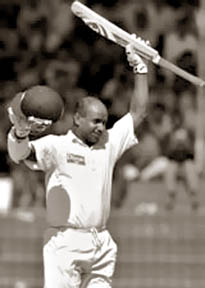|
observer |
|
|
|
|
|
OTHER LINKS |

|

|

|
De Mel redresses injustice - out with outrageous politics
In his prime, Ashantha de Mel, the chairman of selectors, was as aggressive a cricketer as Sri Lanka has ever produced. He could move the ball at a brisk pace. With the bat, he was an audacious late-order hitter. He began playing cricket for Isipathana, a school not known for its cricket. De Mel caught the eye of the powers that be and he moved to the prestigious Royal College, appearing in the centenary big match in 1979. By the time Sri Lanka played test cricket in 1982, the 22 year-old was the country's leading fast bowling hope. It was in the 1983 World Cup in England that de Mel high point came, where he took 18 wickets in six matches making him the most successful bowler of the tournament. This feat continues to be unrecognised by cricket's statisticians. In a World Cup match against New Zealand, the scorers had mistakenly credited one of his wickets to Rumesh Ratnayeke. Despite constant attempts by the Sri Lankan authorities to correct this mistake in the official records, the ICC has not relented. To this day, the records state that Ashantha de Mel took 17 wickets in the World Cup. In English conditions, de Mel could match any of the seamers in the tournament. He invariably took wickets with his first spell. His athletic, sideways-on action was reminiscent of Dennis Lillee, though de Mel lacked the Australians build. If the denial of his rightful status as the 83 World Cup's highest wicket-taker was a gross injustice, de Mel has sought to redress injustice in his new role as the chairman of selectors. As a selector, de Mel has applied the same qualities that made such a successful player. He has been decisive and aggressive. In restoring Sanath Jayasuriya to the squad, de Mel added the experience and exalted talent of one of the definitive players of the modern era. It took a particular blend of outspoken candour and highhanded behaviour for Jayasuriya's place to be restored. It was only the abrasive Ashantha de Mel who could deliver this masterstroke. His predecessor Lalith Kaluperuma was a morose and uncommunicative character, who had shamed the country by joining the 1982 rebel tour to South Africa. By forcing Jayasuriya into premature retirement, Kaluperuma was denying the team its most destructive batsman and the public its most cherished entertainer. The other shockers of Kaluperuma's reign included the omission of Russel Arnold from test cricket, whose future in international cricket is now in doubt. The impact of Jayasuriya's return on the team prospects has been clearly apparent. Apart from his gifted batting, Jayasuriya's has provided variety with his horizontal left-arm spin. He also offers the rich experience of a wizened player with over 16 years of international cricket behind him. Jayasuriya plays the role of the venerable veteran in a team led by his former deputy Mahela Jayawardene. In a way, he is to Jayawardene what former British Premier Harold McMillan was to Margaret Thatcher after she assumed the Prime Minister's post in 1979. His savage assault on the hapless English bowlers in the final one-dayer at Leeds was a shining example of his continuing status as the patron saint of attacking openers. De Mel's survival as the chairman of selector is dependent on the vagaries of Sri Lankan cricket politics. It would take a courageous man to bet on de Mel's reign, even until the next World Cup. Irrespective of his future prospects, de Mel provides the team and administration with the nous of a top-class performer. His detractors should note that he was a selector for several years in the 90s, where he presided over a victorious team. De Mel has the self-confidence to tackle the outrageous politics that is the bane of the island's cricket. His continuation as the chairman is essential for Sri Lanka's prospects in next year's World Cup. |








